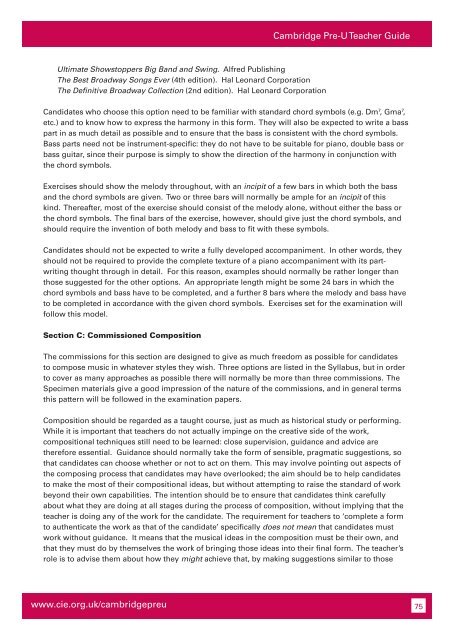Teacher's Guide Cambridge Pre-U MUSIC Available for teaching ...
Teacher's Guide Cambridge Pre-U MUSIC Available for teaching ...
Teacher's Guide Cambridge Pre-U MUSIC Available for teaching ...
You also want an ePaper? Increase the reach of your titles
YUMPU automatically turns print PDFs into web optimized ePapers that Google loves.
Ultimate Showstoppers Big Band and Swing. Alfred Publishing<br />
The Best Broadway Songs Ever (4th edition). Hal Leonard Corporation<br />
The Definitive Broadway Collection (2nd edition). Hal Leonard Corporation<br />
<strong>Cambridge</strong> <strong>Pre</strong>-U Teacher <strong>Guide</strong><br />
Candidates who choose this option need to be familiar with standard chord symbols (e.g. Dm 7 , Gma 7 ,<br />
etc.) and to know how to express the harmony in this <strong>for</strong>m. They will also be expected to write a bass<br />
part in as much detail as possible and to ensure that the bass is consistent with the chord symbols.<br />
Bass parts need not be instrument-specific: they do not have to be suitable <strong>for</strong> piano, double bass or<br />
bass guitar, since their purpose is simply to show the direction of the harmony in conjunction with<br />
the chord symbols.<br />
Exercises should show the melody throughout, with an incipit of a few bars in which both the bass<br />
and the chord symbols are given. Two or three bars will normally be ample <strong>for</strong> an incipit of this<br />
kind. Thereafter, most of the exercise should consist of the melody alone, without either the bass or<br />
the chord symbols. The final bars of the exercise, however, should give just the chord symbols, and<br />
should require the invention of both melody and bass to fit with these symbols.<br />
Candidates should not be expected to write a fully developed accompaniment. In other words, they<br />
should not be required to provide the complete texture of a piano accompaniment with its partwriting<br />
thought through in detail. For this reason, examples should normally be rather longer than<br />
those suggested <strong>for</strong> the other options. An appropriate length might be some 24 bars in which the<br />
chord symbols and bass have to be completed, and a further 8 bars where the melody and bass have<br />
to be completed in accordance with the given chord symbols. Exercises set <strong>for</strong> the examination will<br />
follow this model.<br />
Section C: Commissioned Composition<br />
The commissions <strong>for</strong> this section are designed to give as much freedom as possible <strong>for</strong> candidates<br />
to compose music in whatever styles they wish. Three options are listed in the Syllabus, but in order<br />
to cover as many approaches as possible there will normally be more than three commissions. The<br />
Specimen materials give a good impression of the nature of the commissions, and in general terms<br />
this pattern will be followed in the examination papers.<br />
Composition should be regarded as a taught course, just as much as historical study or per<strong>for</strong>ming.<br />
While it is important that teachers do not actually impinge on the creative side of the work,<br />
compositional techniques still need to be learned: close supervision, guidance and advice are<br />
there<strong>for</strong>e essential. Guidance should normally take the <strong>for</strong>m of sensible, pragmatic suggestions, so<br />
that candidates can choose whether or not to act on them. This may involve pointing out aspects of<br />
the composing process that candidates may have overlooked; the aim should be to help candidates<br />
to make the most of their compositional ideas, but without attempting to raise the standard of work<br />
beyond their own capabilities. The intention should be to ensure that candidates think carefully<br />
about what they are doing at all stages during the process of composition, without implying that the<br />
teacher is doing any of the work <strong>for</strong> the candidate. The requirement <strong>for</strong> teachers to ‘complete a <strong>for</strong>m<br />
to authenticate the work as that of the candidate’ specifically does not mean that candidates must<br />
work without guidance. It means that the musical ideas in the composition must be their own, and<br />
that they must do by themselves the work of bringing those ideas into their final <strong>for</strong>m. The teacher’s<br />
role is to advise them about how they might achieve that, by making suggestions similar to those<br />
www.cie.org.uk/cambridgepreu 75
















